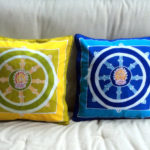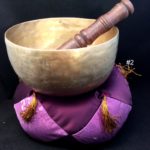Description
4 1/8 x 2 inches tall. Very old Tibetan singing bowl hand selected by Domo Geshe Rinpoche while in the Orient. Also comes with wooden singing bowl stick and unstuffed brocade cushion. Excellent sound. 50.00
The history of singing bowls begins at a time and culture with few written records millenia prior to the advent of modern industrialization.
While there is some folklore about the makers of the singing bowls, typically knowledge of a singing bowl’s origin died with its first or second owner. Bowl making was literally a cottage industry with crude smelting and careful metalworking taking place in the home of the artisan.
Sound Healing – Made to Order
Singing bowls were often made to order; for some of the most special bowls a highly skilled artisan might be provided with very unique materials. Many Tibetan singing bowls were made in Nepal as were a number of other manufactured items
over the last millennium. It’s likely that specific sound qualities were designed with sound healing in mind.
Some singing bowls such as bowls with linghams, were obviously made for ceremonial use. Some singing bowls bear inscriptions indicating they were gifts to monasteries. The incredible musical qualities of some singing bowls would lead one to believe these were intentionally tuned for specific resonance. The fact that it is possible to make functional brass bowls with less expensive metals is evidence many premium quality singing bowls were made with sound in mind. However, the real history of the bowls and intentions of the makers are lost in time.
The Tibetans had the gold and the Nepalis the skills. Many Tibetan singing bowls and other ritual objects were made in Nepal, often of material that originated in Tibet, and then sent over the Himalayas. There is disagreement about whether large numbers singing bowls were ever made in Tibetan monasteries. We know that metallurgy of the type used in the bowls has existed in this area for thousands of years. The tremendous pressure that created the Himalayas also created unique alloys of metals, which are close to the surface. Antique copper and antique brass objects are relatively common in this part of the world.
What Were Singing Bowls Used For?
I have done some research into the instances of brass and copper bowl use documented in Nepal and Tibet by English language sources published sources prior to 1950. The most common uses I found were for storage of water and grains and for use as bowls and cups. There were a number of references to brass bowls being a common dowry item or wedding gift which would attest to their practical utility. Bowls were used in conjunction with charcoal and tobacco. I came across to one reference where a bowl was used for divination (via reading a broken egg). There are relatively few references to bowls and sounds. In a way this isn’t surprising as many inner practices were entirely hidden from outsiders, especially in virtually inaccessible Tibet.
Bowl Stories
One story I heard about the making of the Tibetan singing bowls was that an order for a set of singing bowls might include instructions such as “dig in the riverbank at such and such location”. The idea is that unique alloys were specifically chosen for some of the singing bowls. One of the beauties of antique singing bowls is the individuality of their composition. In addition to copper and tin there are traces of many other metals; up to 12 different metals in some cases.
While the term Tibetan singing bowl might be a modern construction the blending of sound and practice goes back further in Tibet even than the introduction of Buddhism In the Bon tradition as well as all the schools of Tibetan Buddhism bells, horns and gongs are used in ceremony. One early visitor to Tibet reported in a 1909 book of witnessing a ceremony of a thousand monks each making a sound with their own bowl. People have told me of meeting Tibetan refugees in the 1960’s and 1970’s who were selling “sound bowls” they had brought over the Himalayas. Just like the bowl makers art many of these sound practices have been lost. It is a rare Tibetan teacher that makes use of singing bowls in their practices today.
Recent History
What we do know is that in the recent past, say 50-60 years ago, handmade brass bowls were the staple in kitchens and the marketplace for storage eating and cooking. You never see spices in a street market displayed in a singing bowl or get served dal in one anymore but that was common in living memory.









Reviews
There are no reviews yet.